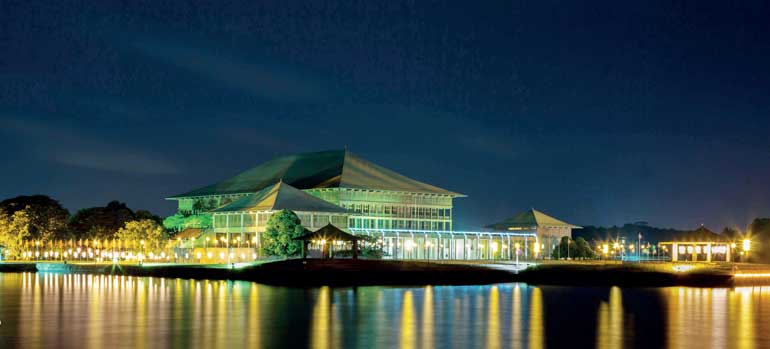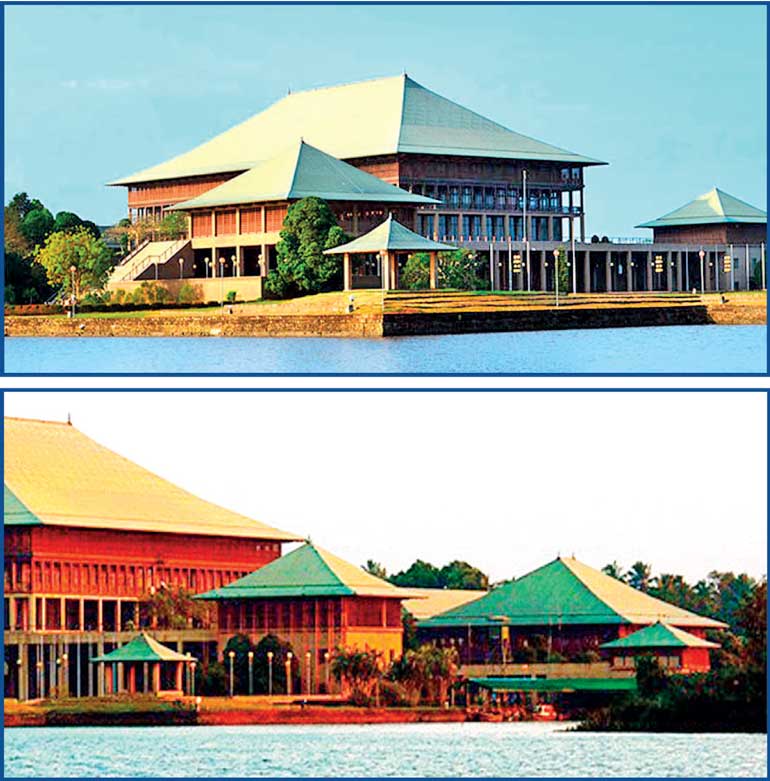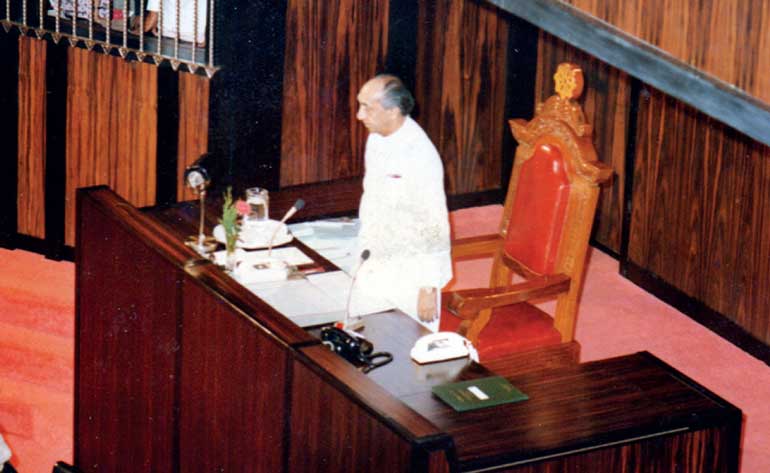Friday Jan 02, 2026
Friday Jan 02, 2026
Saturday, 30 April 2016 00:00 - - {{hitsCtrl.values.hits}}
 By D.C. Ranatunga
By D.C. Ranatunga
It’s the morning on Thursday 29 April 1982. President J.R. Jayewardene is heading for Kotte. His destination is the new Parliament. At the auspicious hour of 10:28, President Jayewardene addresses the second session of the First Parliament of The Democratic Socialist Republic of Sri Lanka. It marks the ceremonial opening of the new Parliament at the Sri Jayavardhanapura Kotte (spelt as recorded in the Hansard). Exactly 34 years ago.
“In this Temple of Democracy let us so conduct ourselves for the welfare of the many that generations yet unborn may say that within the Chamber our words and conduct represented out finest hours,” is how he concluded his address, after briefly tracing the history of parliamentary system of government in Sri Lanka. He paid tribute to the “famous sons of Sri Lanka elected by the people”, who had passed away and also related the story behind the new building.
He mentioned the names of Sir Ponnambalam Ramanathan (1851-1930), Sir James Peiris (1856-1930), Sir D.B. Jayatilake (1868-1944), E.W. Perera (1875-1953), D.S. Senanayake (1884-1952), W.A. de Silva (1869-1942), Sir Francis (1884-1951), S.W.R.D. Bandaranaike (1899-1959), Sir John Kotelawala (1897-1980), Dudley Senanayake (1911-73), T.B. Jayah (1890-1960), Geoge E. de Silva (1879-1950), A.E. Goonesinha (19891-1967), Philip Gunawardena (1901-72), N.M. Perera (1905-79), G.G. Ponnambalam (1901-77), S.J.V. Chelvanayaka (1898-1977) and S.A. Wickramasinghe (1901-81). He stated that there were several others whose names are part of the political history of the country.
“They belonged to two generations that preceded the generation that sits in this Chamber today. I have been associated with all of them, except Sir Ponnambalam Ramanathan and Sir James Peiris, during the 44 years of my public career. My father and his brothers were Sir Ponnambalam Ramanathan’s sponsors in the 1911 election and they worked with Sir James Peiris and some of the others mentioned above to establish the Ceylon National Congress,” he said.
He referred to a Mr. Vaithialingam, the only Member of the 1931 State Council elected by universal franchise alive(in 1982) and two who were Members of the second State Council – himself elected in 1943 and W. Dahanayake elected in 1944.
“Both of us have seen these assemblies in peaceful periods and also in turbulent moods. We have both been State Councillors, Members of Parliament, back-benchers, Ministers, Opposition Leaders and Prime Ministers and I am sure it is as much a pride to him as it is to me to be able to be with you today,” President Jayewardene said.
A new building
The decision to construct a new building for the House of Representatives was first taken in April 1967 during the Dudley Senanayake Government but it was not until after the J.R. Jayewardene Government was formed in July 1977 that it took effect. Renowned architect Geoffrey Bawa was selected to design it and Mitsui Ltd. were chosen as the builders.
The President followed up with a brief history of the kingdom of Kotte and referred to the new building’s features which represent the culture and heritage of the past and embody the hopes and aspirations of everyone for the future. “We commence here a new era of Parliamentary Democracy in a Chamber worthy of an Elected and Sovereign Assembly.”
“What should be the standard of conduct we should maintain?” he then questioned. “Let us ask ourselves the questions the Buddha asked when King Ajasatta of Magadha sought his advice as to whether they should go to war with the Republic of Vaggis: Do the Vaggis have frequent gatherings? Are they well attended? Do they assemble and disperse peacefully? Do they attend to their affairs in concord? Do they proceed in accordance with their ancient laws? Do they show respect and honour, esteem and veneration towards their shrines? These conditions lead to a nation’s welfare. If they follow them, their growth is to be expected, not their decline,” the Buddha said.

From Gordon Gardens…
It was the third time that the country’s Legislature moved. The start was with the Legislative Council in 1833 housed at the present Foreign Affairs Ministry building opposite Gordon Gardens in Colombo Fort.
In 1912, Governor Sir Henry McCallum (1907-13) indicated that new Public Offices and Council Chamber should be erected of “a type worthy of the Colony” and the Chamber should be “a handsome one provided with its own accessories and committee rooms”.
It was land reclaimed from the Beira Lake between the military barracks and the lake that was used to build the new Council and the Secretariat. Governor Sir Herbert Stanley (1927-31) opened the new building on 29 January 1930 and 50 Members of the State Council sat there from 1931-47. By the time Members of Parliament were elected to the first House of Representatives in 1947, the number had increased to 101. The shift to Kotte – also to a building built in an island at Diyawanna Oya – saw 168 MPs coming over. After further increase, today the number stands at 225.
Prime Minister Ranasinghe Premadasa, addressing the inaugural session, referred to the increase of congestion in Colombo with even basic services of water supply, electricity and telecommunications being endangered.
“Land prices have reached astronomical heights. The new capital city around the nucleus of the Parliament building will not only ease the pressure on Colombo but also open out a vast area for development. The new roads that lead there along with the service facilities will help to bring prosperity to the people living in the Greater Colombo area,” he said.
Reminding that the nation was wholly committed to the democratic way of life and that the 50th anniversary of the grant of Universal Adult Franchise to the people was just the previous year, he said: “We have climbed a hard and arduous path. We have won by our own efforts the democratic rights and privileges we now cherish. Our people will not lightly part with these hard-won rights. They will surely be on their guard against those who seek to usurp those rights, either surreptitiously or openly.”
Stressing that in Sri Lanka the sovereign power is vested with people, he added: “We are their servants. Their wishes are our commands. The sovereignty of the people is expressed through Parliament. No act can be legal unless it has the approval of Parliament. This is so even at the height of an emergency. All our acts, without exception, must face the scrutiny of Parliament.”
 President J.R. Jayewardene addressing Parliament on the first day
President J.R. Jayewardene addressing Parliament on the first day
Revival of a glorious heritage
Leader of the Opposition A. Amirthalingam referring to the shift of the capital from Colombo to Kotte described as a prelude to the revival of the glorious heritage of the Sinhalese during the Kingdom of Kotte, said that the Tamil people do not grudge the Sinhalese the restoration of what was theirs.
“We believe in a policy of live and let live. We believe in co-existence with the Sinhalese on a basis of equality and freedom. We certainly resent and will fight against any set-up under which we are made second-class citizens and a subject nation.”
Reminding that the word ‘Kotte’ itself is a Tamil word, meaning a fort, he said that the city took its name from a fort built by a Tamil by the name of Alagakkonara. He added that when the capital was established at Kotte in the 14th century there were two other kingdoms – one a Sinhalese kingdom in the central hills with its capital at Gampola and the other a Tamil kingdom in the north with its capital at Nallur.
He appealed that while there was an attempt to revive and resuscitate ancient Sinhalese greatness, there should be a similar revival of ancient Tamil greatness. “Let not one wilt and wither while the other revives and blooms. Both nations were free during the Kotte period. Both languages flourished during that period. All religions, particularly Buddhism and Hinduism, were thriving during that period. Let us hope that the new Kotte era will lead to the revival of the Kotte spirit, the spirit of equality, the spirit of freedom for all. Let us find a modus vivendi, a means of co-existence as friends, recognising the equality and the right to self-determination, the right to freedom of the nations occupying this island.”
Tribute to Sir Ponnambalam Ramanathan
After Maitripala Senanayake spoke on behalf of the SLFP and Sarath Muttetuwegama for the Communist Party, Kotte MP/Minister of State Anandatissa de Alwis took the floor. He agreed with the Leader of the Opposition that Alagakkonara discovered Kotte but reminded him that he later preferred to be called Alagkeshwara.
Paying a tribute to Sir Ponnambalam Ramanathan, he said that the Sinhalese people must express their gratitude to a great person. “When Sinhala leaders were in prison and British imperialism had them in the palm of their hand, including the redoubtable E.W. Perera of Sri Jayavardhanapura Kotte, who represented Horana in the State Council in al later period, one man, and one man alone, stood up against the might of British power and that man was a Tamil, and that Tamil, accustomed as we are to be grateful, accustomed as we are as a nation to face the truth with humility and gratitude, to that man I say on the Floor of this House, ‘Thank You’. That act made possible the growth of democratic freedom for our people and the power that they now enjoy.”
Minister de Alwis hoped that “in this House we shall always ensure that it will be the perennial spring of liberty that all of our people will equally enjoy and that every deliberation that is undertaken in this House will lead to prosperity and that we shall be able to be merely the sources by which we will express what is there deeply implanted in mankind. In the words of the greatest orator who ever spoke in this House, the late S.W.R.D. Bandaranaike, I would call that ‘the unconquered and unconquerable spirit of man’.”
President Jayewardene who presided over the entire session from the Speaker’s Chair declared the proceedings of the day concluded at 1:08 p.m.